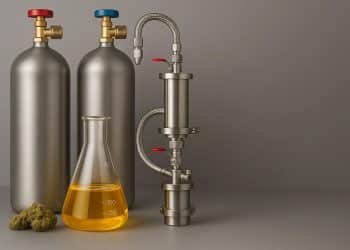Using Grain Alcohol as a Solvent in Cannabis Extraction
Ethanol refers to ethyl alcohol (C2H6O) or in the vernacular, grain alcohol. Most know ethanol for its ubiquity in alcoholic beverages. However, it is a versatile substance.
Ethanol derived from plants like corn, grain, or sugarcane (energycane) is referred to as bioethanol, a type of biofuel. Several countries, notably Brazil and the United States, use bioethanol as a clean fuel source/additive. But ethanol has another popular use: it is a powerful chemical solvent. Most cannabis extractors utilize ethanol in post-extraction processing, and some choose it over the other commonly-used solvents for extraction.
Safety is one reason extractors choose ethanol. Food-grade ethanol is a Generally Recognized as Safe (GRAS) food substance, according to the FDA. It is a class 3 solvent derived from food sources (like those mentioned above), with low toxicity risk, acceptable at residual levels of 5,000 ppm (or 0.5%). The Occupational Safety & Health Administration (OSHA) sets a lower limit of 1,000 ppm (0.1%) and points out that ethanol is dangerous in large quantities due to its flammability. Vapors can create an explosion hazard. Proper storage, ventilation, and safety relief valves are essential. Nonetheless, ethanol is still considered safer than conventional hydrocarbon solvents, especially as a residual. [1]
Efficiency also makes ethanol an attractive choice for extraction. A low boiling point of 78.5 °C allows for relatively easy evaporation. As a universal solvent, it dissolves polar and nonpolar compounds. Drawing out the full profile of terpenes and cannabinoids, the polarity of ethanol is a double-edged sword that additionally strips chlorophyll and wax from the plant, requiring purification and dewaxing. [1]
Cold ethanol extraction is a strategy designed to reduce the extraction of chlorophyll and wax. Super-cooling reduces polar solubility… at the expense of some cannabinoids and terpenes. Patented technologies are emerging to resolve this bind. One example is Capna Systems’ Ethos, which sprays cannabis with sub-zero 200 proof ethanol and sends the solution through micron filtration with negative pressure.
Ethanol can be used as a co-solvent in CO2 extraction; a 2019 study in the Journal of Supercritical Fluids found that the application of ethanol in pulses throughout supercritical CO2 extraction led to efficiency as high as 92%. [2] Even when CO2 extraction is used as the primary method, ethanol is often the top choice for winterization, or separation of remaining plant lipids.
The required ratio of ethanol-to-cannabis is one concern worth mentioning. Writing for Cannabis Business Times, Dr. June-Wells commented, “best-case scenario is that the amount of ethanol required ranges from 0.5 gallons to 0.6 gallons per pound.” Recycling may require additional equipment, and storing large quantities involves safety risk.
As ethanol makes its way onto the main stage of cannabis extraction, innovation will define whether it triumphs over other methods.
References
- Romano, L.L. & Hazekamp, Arno. “Cannabis Oil: Chemical Evaluation of an Upcoming Cannabis- based Medicine.” Cannabinoids, vol. 1. 2013, pp. 1-11. Times Cited = 25 (Research Gate)
Rovetto, L., et al. “Supercritical Carbon Dioxide Extraction of Cannabinoids from Cannabis Sativa L.” The Journal of Supercritical Fluids, vol. 129, 2017, pp. 16–27. Journal Impact Factor = 3.122, Times Cited = 17 (Google Scholar)












